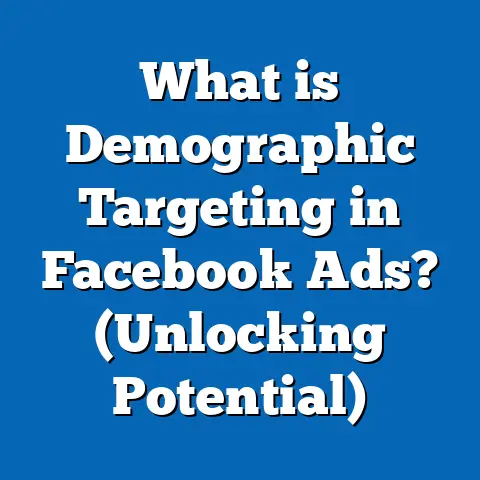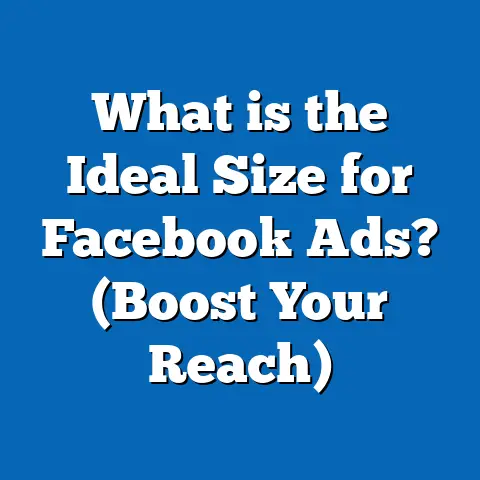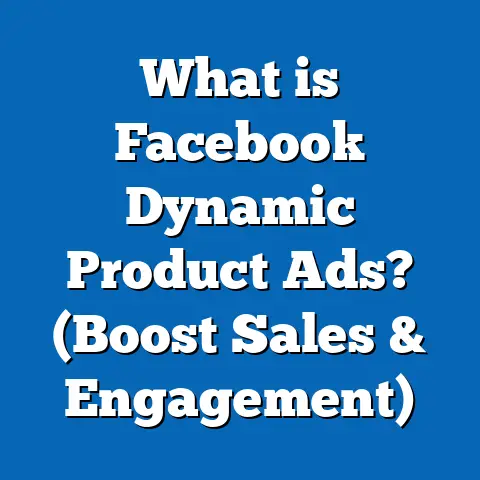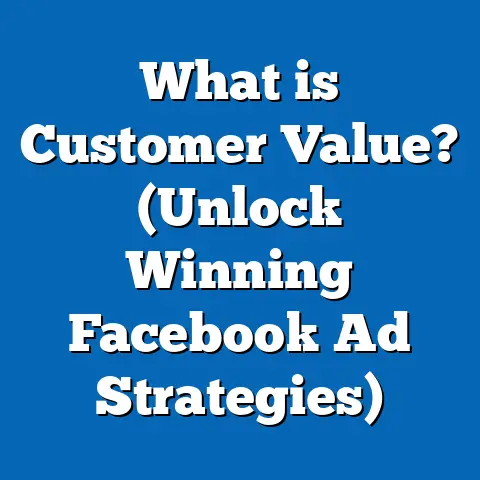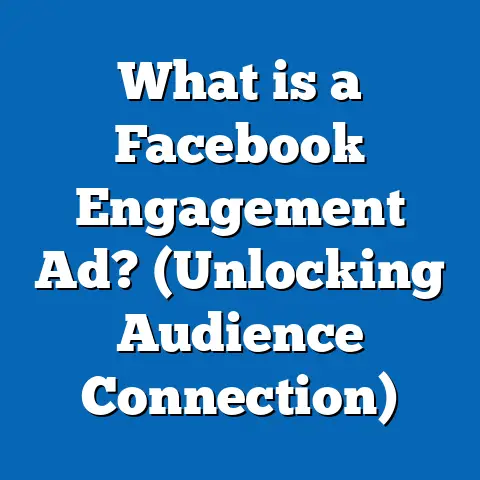What is a Facebook Ad Form? (Unlocking Audience Engagement)
What is a Facebook Ad Form? (Unlocking Audience Engagement)
Introduction: The Power of Eco-Conscious Choices in Advertising
In a world increasingly driven by eco-conscious decisions, the way businesses reach and engage their audience is evolving rapidly. Consumers today expect brands to be responsible, transparent, and user-friendly—not just in product offerings but also in how they communicate and interact online. This shift has profound implications for digital marketing strategies. Among these strategies, Facebook Ad Forms stand out as a revolutionary tool for marketers aiming to connect with audiences efficiently, ethically, and effectively.
Facebook Ad Forms, or Lead Ads, allow brands to collect valuable audience information without forcing users to leave their social media platform. This seamless integration aligns perfectly with modern consumers’ preferences for convenience and privacy. As eco-consciousness influences buying behavior, marketers who adopt tools that respect user experience and data privacy will likely see stronger engagement and better conversion rates.
This guide dives deep into what Facebook Ad Forms are, how they work, their key features, data-driven benefits, practical applications, comparisons with other platforms, advanced strategies, and the latest trends—all aimed at helping marketing professionals and business owners unlock powerful audience engagement.
Understanding Facebook Ad Forms: Definition and Core Features
What is a Facebook Ad Form?
Facebook Ad Forms are a specialized advertising format designed to generate leads directly inside the Facebook or Instagram app. Unlike traditional ads that direct users to external websites for lead capture, these forms appear within the platform itself after users click on a call-to-action button. The form can be customized to collect different types of information such as names, emails, phone numbers, or more detailed responses through custom questions.
This format minimizes barriers by auto-filling user information from their profile, reducing the time and effort required to complete the form. It works exceptionally well on mobile devices where typing can be cumbersome.
Core Features
- Embedded Lead Capture: Forms open within Facebook or Instagram without redirecting users.
- Auto-Fill Capability: Pre-populates fields using user profile data for faster completion.
- Customizable Fields: Advertisers can add multiple-choice, short answer, or conditional questions.
- Privacy Policy Link: Mandatory inclusion ensures compliance with data protection laws.
- Thank You Screen: Allows personalized messages or next-step calls to action after submission.
- CRM Integration: Leads can be automatically sent to Customer Relationship Management systems.
- Mobile Optimization: Designed to provide frictionless experience on smartphones and tablets.
Why Facebook Ad Forms Matter for Marketers Today
Seamless User Experience Drives Higher Conversions
One of the biggest obstacles in lead generation is the friction caused by moving users away from familiar platforms to external landing pages. According to research by HubSpot, 70% of mobile users abandon forms due to complexity or slow loading times. Facebook Ad Forms eliminate this friction by keeping the process within the app where users are already comfortable.
Data Privacy and Trust
In an era where data privacy concerns are paramount—spurred by regulations like GDPR and CCPA—users are cautious about sharing personal information. Facebook’s native form format clearly displays privacy policies and auto-fills verified data, which helps build trust and reduces form abandonment.
Cost Efficiency
According to Facebook’s internal data and third-party studies:
- Cost per lead (CPL) can be reduced by up to 35% compared to traditional landing page ads.
- Conversion rates increase by approximately 20-30%.
- Mobile form completions happen up to 70% faster than external forms.
For businesses targeting mobile-first audiences or those sensitive to lead acquisition costs, Facebook Ad Forms offer a powerful solution.
The Mechanics of Facebook Ad Forms: How They Work
Step-by-Step User Journey
- Ad Delivery: The user sees a Lead Ad on their Facebook or Instagram feed.
- Call-to-Action Interaction: The user clicks a button labeled “Sign Up,” “Get Quote,” “Subscribe,” or similar.
- Form Display: A form pops up within the app, pre-filled with any available user data (e.g., name, email).
- User Completes Form: The user fills out any additional requested fields.
- Form Submission: Data is submitted through the platform.
- Lead Capture: The advertiser accesses leads via Facebook Ads Manager or CRM integration.
- Follow-Up Engagement: Leads are nurtured through email campaigns, phone calls, or retargeting ads.
Customization Opportunities
Advertisers can tailor their forms based on campaign goals:
- Field Types:
- Standard (name, email)
- Custom questions (preferences, interests)
- Conditional logic (show/hide questions based on answers)
- Privacy Policy Link: Required URL pointing to advertiser’s privacy statement.
- Thank You Screen:
- Displays customized messages
- Can include links or buttons guiding next steps
Data-Backed Insights and Statistics on Facebook Ad Forms
Conversion Rates and Cost Effectiveness
- Conversion Rate: WordStream reports an average conversion rate of 12.2% for Facebook Lead Ads vs. 9.2% for traditional ads.
- Cost Savings: Facebook claims CPL reductions of up to 35%.
- Mobile Speed: Users complete Lead Ads forms roughly 70% faster than external web forms.
Audience Preferences and Trust Factors
- 64% of users prefer auto-filled forms compared to manual input (Facebook internal research).
- Personalized questions improve submission rates by 15% (HubSpot).
- 42% of consumers hesitate to share data due to privacy concerns; clear privacy policy links increase trust significantly.
Industry-Specific Success Rates
According to Salesforce research:
| Industry | Average CPL (Facebook Lead Ads) | Conversion Rate (%) |
|---|---|---|
| Real Estate | $18 | 14 |
| Automotive | $22 | 13 |
| Education | $12 | 15 |
| Retail & E-commerce | $8 | 11 |
Practical Applications of Facebook Ad Forms
Use Cases by Industry
Real Estate
Facebook Ad Forms help real estate agents capture buyer interest quickly with fields for budget, preferred neighborhoods, and property types. This immediate connection allows agents to follow up with tailored listings.
Automotive
Dealerships use Lead Ads to schedule test drives or provide instant quotes. Auto-fill reduces friction for busy consumers, increasing appointment bookings.
Education
Schools and training providers use Lead Ads for course inquiries and webinar registrations. The integrated format improves sign-up rates compared to external registration pages.
Retail & E-Commerce
Brands collect newsletter subscriptions or offer exclusive discounts directly through Lead Ads, building email lists efficiently without losing users mid-process.
Case Study: Real Estate Lead Generation Success Story
A mid-sized real estate agency in California implemented Facebook Lead Ads targeting high-intent buyers interested in luxury homes. By customizing forms with specific fields about budget range and preferred features, they achieved:
- A 40% increase in lead quality (measured by lead-to-client conversion ratio).
- A 28% decrease in cost per lead compared to previous campaigns.
- A 33% increase in appointment bookings due to faster follow-up enabled by CRM integration.
This case highlights how tailored form design plus rapid response creates measurable ROI.
Technical Concepts Made Simple: Key Elements of Facebook Ad Forms
Auto-Fill Feature Explained
Facebook pulls user-provided information such as name, email address, and phone number directly from their profiles. This pre-filling reduces friction significantly because users avoid typing lengthy details on mobile devices.
Lead Delivery Methods: Manual vs Automated Integration
Manual Download
Leads can be downloaded manually from Facebook Ads Manager as CSV files.
CRM Integration
Using third-party tools like Zapier or native API connections, advertisers can send leads directly into CRMs such as:
- HubSpot
- Salesforce
- Mailchimp
- Zoho CRM
Automatic lead delivery facilitates immediate follow-up workflows and reduces potential lead loss.
Compliance and Privacy Considerations
Facebook requires advertisers to provide a link to their privacy policy within the ad form. This transparency is crucial for compliance with:
- GDPR (EU General Data Protection Regulation)
- CCPA (California Consumer Privacy Act)
- Other global data privacy laws
Advertisers must ensure collected data is handled securely and used only for stated purposes.
Advanced Strategies for Maximizing Facebook Ad Form Effectiveness
Progressive Profiling
Instead of asking for all information upfront, divide questions across multiple touchpoints:
- Initial form requests minimal info (e.g., email).
- Follow-up communications gather more detailed data over time.
This reduces drop-off and builds trust gradually.
A/B Testing Elements
Test variations of:
- Call-to-action button text (“Get Quote” vs “Learn More”)
- Number of form fields
- Question types (multiple choice vs short answer)
- Thank you screen messaging
Data-driven optimization helps improve conversion rates continuously.
Leveraging Lookalike Audiences
Create lookalike audiences based on existing high-quality leads captured via Facebook Ad Forms. This strategy targets new prospects sharing similar behaviors and demographics, improving lead quality.
Integrating Facebook Ad Forms with Other Marketing Channels
Email Marketing Automation
Leads collected can automatically enter drip campaigns designed for:
- Welcome sequences
- Product education
- Special offers or discounts
Automation nurtures leads efficiently until ready for sales conversion.
Retargeting Campaigns
Use collected leads or website visitors from Lead Ads for retargeting ads on Facebook/Instagram or Google Display Network. Retargeting increases brand recall and conversion probability.
SMS Marketing
Integrate phone numbers collected through forms into SMS campaigns for timely alerts or promotions with high open rates (~98%).
Comparing Facebook Ad Forms with Other Lead Generation Tools
| Feature | Facebook Ad Forms | Google Lead Form Extensions | Landing Page Lead Forms |
|---|---|---|---|
| User Experience | On-platform seamless | On-platform seamless | External page load required |
| Mobile Optimization | Fully optimized | Optimized | Varies by website |
| Auto-Fill Capability | Yes | Yes | No |
| Customization Options | Extensive | Limited | Extensive |
| Privacy Compliance | Built-in with mandatory link | Basic compliance | Depends on setup |
| Integration Ease | Native & third-party tools | Limited | Wide but manual |
| Cost Efficiency | Lower CPL in many cases | Competitive | Generally higher CPL |
Latest Trends and Features in Facebook Ad Forms
AI-Powered Recommendations
Facebook now offers AI-driven suggestions for optimal form fields based on campaign objectives and past performance data. This helps advertisers create more effective forms without guesswork.
Enhanced Analytics Dashboard
Marketers can analyze where users drop off inside the form submission process, enabling targeted improvements in question order or phrasing.
Multi-Language Support
Forms automatically display in the user’s preferred language based on their profile settings, facilitating global campaigns with localized messaging.
Real World Examples of Successful Campaigns Using Facebook Ad Forms
Example 1: Automotive Dealer Boosts Test Drive Bookings
A regional car dealership used Lead Ads with custom questions about preferred models and financing options. After integrating leads with their CRM for instant follow-up calls:
- Test drive bookings rose by 42%
- Cost per lead decreased by 30%
- Customer satisfaction scores improved due to faster response times
Example 2: Online Course Provider Increases Webinar Sign-Ups
An e-learning platform used Facebook Lead Ads targeting professionals interested in digital marketing courses. By offering a free webinar sign-up via Lead Ads:
- Registrations increased by 55%
- Webinar attendance improved by 20% due to streamlined signup
- Post-webinar conversions into paid courses increased by 18%
Step-by-Step Guide: Creating Your First Facebook Ad Form Campaign
Step 1: Define Your Goal
Identify what type of leads you want (e.g., newsletter subscribers, product inquiries).
Step 2: Set Up Campaign in Facebook Ads Manager
Choose “Lead Generation” as your campaign objective.
Step 3: Target Your Audience
Select demographics, interests, behaviors relevant to your business.
Step 4: Design Your Lead Form
- Add relevant fields
- Include privacy policy URL
- Customize thank you screen message
Step 5: Create Engaging Ad Creative
Use clear CTAs like “Sign Up Now” paired with compelling images/videos.
Step 6: Launch Campaign and Monitor Performance
Track CPL, conversion rates, and optimize based on data insights.
Common Challenges and How to Overcome Them
| Challenge | Solution |
|---|---|
| Low form completion rates | Simplify form; reduce number of fields |
| Poor lead quality | Use qualifying questions; target better audiences |
| Privacy concerns | Clearly link privacy policy; explain data usage |
| Slow follow-up | Integrate CRM; automate notifications |
| Technical integration issues | Use trusted third-party tools; test before launch |
Clear Takeaways for Marketers and Business Owners
- Facebook Ad Forms simplify and speed up lead collection, resulting in higher conversion rates.
- They offer better user experience, especially on mobile devices.
- Their built-in privacy compliance features build user trust, important in today’s regulatory environment.
- Combining customized forms with automation tools boosts lead quality and immediate engagement.
- Use data analytics and A/B testing consistently for ongoing optimization.
- Incorporate Lead Ads into a broader marketing ecosystem including email nurturing and retargeting.
- Stay updated on new features like AI recommendations and multilingual support.
- Compare alternatives but recognize that Facebook Lead Ads often provide superior cost efficiency especially for mobile-first audiences.
This comprehensive understanding of Facebook Ad Forms equips marketers with the knowledge needed to harness this powerful tool effectively—unlocking deeper audience engagement while respecting modern consumer expectations around convenience and privacy.
If you want me to provide additional sections like detailed tutorials on integration with specific CRMs or more case studies from various sectors, just let me know!


